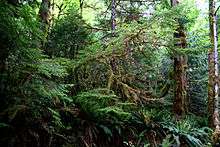Humboldt's flying squirrel
Humboldt's flying squirrel (Glaucomys oregonensis) is one of three species of the genus Glaucomys, the only flying squirrels found in North America. Using genetic analyses, Arbogast et al. (2017)[1] showed that Humboldt's flying squirrel, previously thought to be conspecific with the northern flying squirrel, was actually a distinct species. These squirrels do not actually fly but glide from tree to tree.[2] Humboldt's flying squirrels are found in coniferous and mixed coniferous forests from southern British Columbia to southern California.[3] They are similar in appearance to the northern flying squirrel, however, they are generally smaller and have darker pelage. They are good gliders but clumsy walkers on the ground. They feed on a variety of plant material as well as tree sap, fungi, insects, carrion, bird eggs and nestlings. They mostly breed once a year in a cavity lined with lichen or other soft material. Unlike most members of their family, flying squirrels are strictly nocturnal.[4]
| Humboldt's flying squirrel | |
|---|---|
 | |
| Scientific classification | |
| Kingdom: | Animalia |
| Phylum: | Chordata |
| Class: | Mammalia |
| Order: | Rodentia |
| Family: | Sciuridae |
| Genus: | Glaucomys |
| Species: | G. oregonensis |
| Binomial name | |
| Glaucomys oregonensis (Bachman, 1839) | |
Habitat

The Humboldt's flying squirrel can be found in British Columbia, California, Oregon, and Washington.[5] They live in thick coastal forests where there is plenty of room for them to glide from tree to tree. They nest in the tops of the trees away from the ground from predators.
References
- Arbogast, Brian S.; Schumacher, Katelyn I.; Kerhoulas, Nicholas J.; Bidlack, Allison L.; Cook, Joseph A.; Kenagy, G. J. (2017). "Genetic data reveal a cryptic species of New World flying squirrel: Glaucomys oregonensis". Journal of Mammalogy. 98 (4): 1027–1041. doi:10.1093/jmammal/gyx055.
- "Meet This Newly Discovered Flying Squirrel". 2017-05-30. Retrieved 2018-01-12.
- Morell, Virginia (May 30, 2017). "Meet This Newly Discovered Flying Squirrel". National Geographic. Retrieved 30 June 2017.
- "New Flying Squirrel Species Discovered along North America's Pacific Coast". Humboldt State University. June 5, 2017. Retrieved 30 June 2017.
- "Meet This Newly Discovered Flying Squirrel". 2017-05-30. Retrieved 2018-01-12.